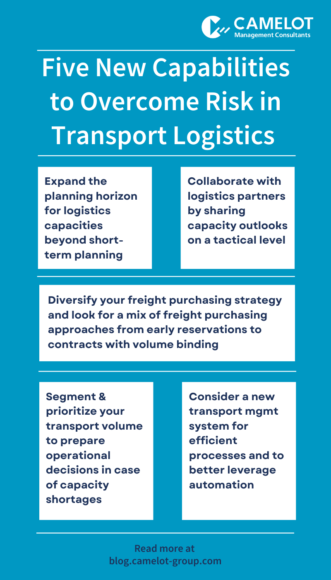Logistics has been always heavily affected by global megatrends and constantly changing market environments. The globalization of supply chains and the rise of customer-centricity in combination with significant demand volatility as well as the advancing digital transformation posed serious challenges to logistics managers in the pursuit of adequate solutions.
The situation today is no less demanding. One of the most compelling challenges in logistics today affects all industries, puts significant pressure on logistics managers both from a cost and a service point of view and leads to instability in global supply chains. As a consequence of considerable capacity constraints, the logistics market changed from a “buyer” to a “seller” market, which, in the logistics terminology, means a more dominant position of carriers over shippers.
Overcoming the Risk in Transport Logistics with New Capabilities
Serious capacity limitations associated with rising logistics costs are posing an urgent risk for a company´s delivery capability, asking for new capabilities in transport logistics.
1. Extension of the planning horizon for logistics capacities
Transportation planning beyond the short-term transport request view is providing valuable insights for capacity requirements in the longer run. A forward-looking approach includes incorporating supply chain planning and forecasting, breaks up silo thinking and helps logistics to move beyond firefighting mode to provide a strategic contribution to company success.
2. Closer collaboration with logistics partners
Regularly sharing capacity outlooks with transportation partners also on tactical level goes beyond the pure operational subcontracting and tendering relationship, as it facilitates a better plannability on the LSP side and, ultimately, leads to a more secure capacity situation even in peaks.
3. Diversified freight purchasing strategy
As also pointed out in our CHEManager article, different requirements in terms of transport mode, product portfolio, expected service level and seasonality, call for a diversified strategy and an optimal mix of different freight purchasing approaches. Early reservations as well as freight contracts with volume binding help avoid the risk of short-term capacity shortages and, therefore, contribute to the maintenance of delivery capability.
4. Transport segmentation & prioritization
A sophisticated segmentation of a company’s transport volume is a pre-requisite for an optimal combination of different transport planning and subcontracting models. In case of capacity shortages, conscious operational decisions on priorities are necessary under consideration of the impact on the cost level as well as for the supply chain operation and the end customer.
5. Streamlined logistics IT landscape
A powerful and state-of-the art transport management system not only is a central cornerstone of the supply chain execution landscape, but essential to efficiently manage collaborative processes like capacity management with logistics partners, with a high level of automation.
Developing a Clear Logistics Vision is Key to Tackle Challenges
The constant refinement of competitive advantages is an essential task for logistics managers especially in today´s volatile market environment. Under these considerations, the existence of a clear strategic vision and a coherent target picture that both act as major guiding principles are of utmost importance.
Foresighted logistics and supply chain leaders are well advised to constantly assess the readiness of their operating model (for example based on best practices from the CAMELOT maturity model for organization, process & IT aspects). The goal is to answer the question: are the necessary capabilities in place to make logistics generate the expected added value for the entire company?
It is important to point out: new capabilities must be properly embedded into the operational process and IT landscape to exploit their full potential. Recently, many companies have been acknowledging the importance of having increased control on supply chain execution operations and started initiatives to streamline their respective processes, build up dedicated transport logistics functions in-house and replace their outdated system environment.
The implementation of new systems in supply chain execution is also fueled by the “S/4 trend”. Companies are running big programs to put their entire operating system landscape on a new technological basis. These initiatives give the opportunity for a re-design of the global supply chain operations as well, leading to improved operational efficiency and increased level of digitalization. With the right positioning of logistics in these endeavors, the necessary capabilities can be enhanced and a properly integrated transport management can develop.
Address Upcoming Challenges with a Holistic View
We at CAMELOT firmly believe that today´s logistics challenges have to be addressed with a holistic view. A future-proof logistics target vision based on a clear awareness of one’s own value generation is an essential pre-requisite for any process improvement or IT landscape-related initiative. On the other side though, even the best strategy and the highest value-adding concept is unable to unfold their positive impact when it is not properly embedded into the company´s logistics operating model.
A clear strategic direction, underpinned by innovative concepts with real logistics value generation, implemented into an efficient process landscape and supported by a state-of-the art IT environment is the way logistics managers should embark on to secure the long-term contribution of logistics to the company´s overall success.


